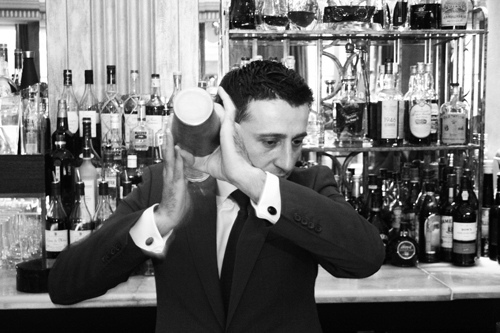
Denis Broci, Claridges Bar-photo courtesy of http://www.thecocktaillovers.com
I love hotel bars. I love their dark glamour and the feeling of being public and private at the same time. Being an ‘indoorsy’ type who thinks spirited conversations are a contact sport, hotel bars are always a must-see on my travels. Also, there is booze. In the afternoons, some bars convert to ‘tea salons’ which also works for me. Basically, anything to be tucked inside a cozy room where the talk is in whispers and nice people bring you food and drink in return for your initials on a piece of paper.
It’s no secret that we guests, or punters as Gordon Ramsay likes to call us, pay an enormous premium to linger in these luxurious places. For many (“Yes, Please!”), it’s money well spent—a haute hospice for the soul. A place to recharge knowing that just outside the velvet-upholstered walls is a thrumming metropolis, and that we choose, for the moment, not to partake.
Liquidity, whether the 5-star hotel kind, or the Mr. Market kind comes with a cost premium. In the stock market, the ability for an investor to be able to enter and exit a position without too much muss-and-fuss is critically important. And there’s a price tag for that.
A recent study by Roger Ibbotson, formerly assistant professor of finance at the University of Chicago and now chief investment officer of a U.S.-based wealth management firm, shows a 7-percent return advantage for holding small-cap illiquid stocks vs. large-cap liquid stocks. Factoring in time-value calculations and compounding, an additional 7-percent annually amounts to huge incremental return over time. (Translated into English: Not paying the premium associated with large, actively-traded stocks gives you the potential for better long-term returns.)
In an investing world that gets crazier by the minute, buying quality companies in the small-to-mid-cap sector can give individual investors a slight edge over institutional investors. Large wealth management companies are constrained in many ways. Firstly, they often have to take very large positions in order to generate expected returns. Also, they need to ensure that they can go in and out of positions rapidly. Their clients are paying hefty management fees and don’t want to see three quarters of losses on their statements.
Retail investors, or punters, do not have these types of limitations. Especially during the accumulation phase of our portfolios, we can wait for the market to recognize value. In fact, it’s advantageous to add to our holdings when stock valuations are depressed. Who doesn’t love to buy on sale?
One strategy is to identify good quality but illiquid public companies. (Hint: many of these are family controlled.) Sometimes they are taken private, so, no problem, you take the cash. Other times they land on the radar of the institutions. Again, no problem. Once this begins to happen, you can happily sell your shares to the Big Boys at a profit.
However, this strategy is not for every taste. If your time horizon is short, liquidity is your friend, so pay for it. If you like to trade frequently, skip this idea. Your eyes will glaze over while you wait for a buyer to emerge. If you like micro-caps, illiquidity can be tricky. The companies may not survive and you’ll be stuck with a worthless share certificate to stuff into drafty windows.
On the other hand, if your picker is good and you have time on your side, this is an excellent way to juice returns. And, when you do finally cash out, why not treat yourself to a week-end stay at Claridges? At the bar, ask for Denis. I hear he makes a mean Mojito Royale.


